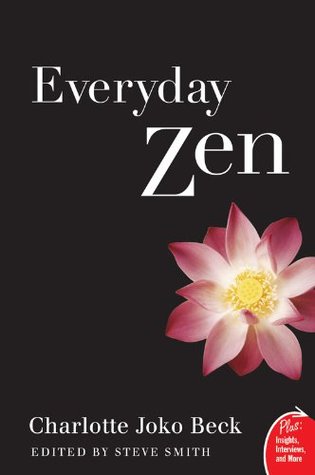More on this book
Community
Kindle Notes & Highlights
If we’re upset we have to experience being upset. If we’re frightened, we have to experience being frightened. If we’re jealous we have to experience being jealous. And such experiencing is physical; it has nothing to do with the thoughts going on about the upset.
When we are experiencing nonverbally we are walking the razor’s edge—we are the present moment. When we walk the edge the agonizing states of separateness are pulled together, and we experience perhaps not happiness but joy. Understanding the razor’s edge (and not just understanding it, but doing it) is what Zen practice is. The reason it’s difficult is that we don’t want to do it. We know we don’t want to do it. We want to escape from it.
A tenth of an inch of difference and heaven and earth are set apart.”)
Practice does expect a great deal of us; but we are just living this moment; we don’t have to live 150,000 moments at once. We are only living one. That’s why I say, “What else do you have to do?—you might as well practice with each moment as not.”
We prefer to “win” in an argument, but if we can’t win, we’d rather lose than not have a drama centered on us. Suzuki Roshi once said, “Don’t be so sure you want to be enlightened. From where you’re looking, it would be awfully dull.” Just doing what you’re doing. No drama.
it dawned on me that I still hadn’t answered that letter. I’d found fifteen things to do from nine to three that were not answering the letter. My initial response was, “I should answer the letter.” That’s conformity. “It’s required of me, I should do it.” The second is, “You can’t make me. I don’t have to do that. I can leave it sitting there.” But the minute the observer sees both states, what happens? When I observed both thoughts I sat down and answered the letter.
In this whole back-and-forth process, there’s nothing but separation. How do we resolve it? We resolve it by experiencing that which we don’t want to experience. We need to experience nonverbally the uncomfortableness, the anger, the fear that is sitting beneath this vacillation between the two poles. That’s true zazen, true prayer, true religious practice. Eventually the anger (as physical experience) will begin to shift. If we’re really upset, the shifting may take weeks or months. But if we surrender to the experiencing, if we “embrace the tiger,” it will always shift—because when we are
...more
And it’s not easy, because we want to cling to that which is familiar: being separate, being superior or inferior, being “someone” in relationship to the world. One of the marks of serious practice is to be alert and to recognize when that separation is occurring. The minute we have even a passing thought of judging another person, the red light of practice should go on.
“As a man thinketh in his heart, so is he.” What really decides any problem is the way we think in our hearts. How we see what our life is. Out of that we make our decision.
Usually, if we have seen through the nature of attachment, we will tend to have fewer possessions, but not necessarily. Most practice gets caught in this area of fiddling with our environment or our minds. “My mind should be quiet.” Our mind doesn’t matter; what matters is nonattachment to the activities of the mind. And our emotions are harmless unless they dominate us (that is, if we are attached to them)—then they create disharmony for everyone. The first problem in practice is to see that we are attached. As we do consistent, patient zazen we begin to know that we are nothing but
...more
Outside of the zendo he was just an ordinary little man running around with his broom and with his pants rolled up, eating carrots. He loved carrots.
Often people have the idea when they begin practice that it is going to be nice and comfortable. But Zen practice has phases that are anything but pleasant. By just sitting in this very moment, the secure walls of the ego structure crumble, and this can be confusing and painful. Physically experiencing the confusion and pain rather than avoiding them is the key to freedom. We have to embrace the misery, make it our best friend, and go right through it to freedom.
Because our major difficulties are with people, we don’t talk as much as we might about our commitment (or lack of it) to objects. For example: if we keep our room a mess, we’re not committed. We are indicating that there’s something more important to us than the objects which are our life.
And sesshin is simply a refusal to meet our expectations! From beginning to end a sesshin is designed to frustrate us! Inevitably, it gives us some pain, mental or physical. It’s a prolonged experience of “It’s not the way I want it!” When we sit with that, there’s always a residue of change left in us. In some cases it’s very obvious. But the people who do best in sesshin are usually the ones who have not sat many sesshins.
The more we are aware of our expectations, the more we see that our urge is to manipulate life rather than live it just as it is. Students whose practice is maturing aren’t angry as often because they see their expectations, their desires, before they produce anger. But if the stage of anger is reached, it is practice. Our signal to practice, our “red light,” is at the point of upset, the disappointment. “It’s not the way I want it!” Some expectation has not been fulfilled and we sense the irritability, frustration, the desire to have it otherwise. “I want” has been frustrated. This very point
...more


